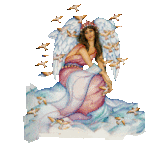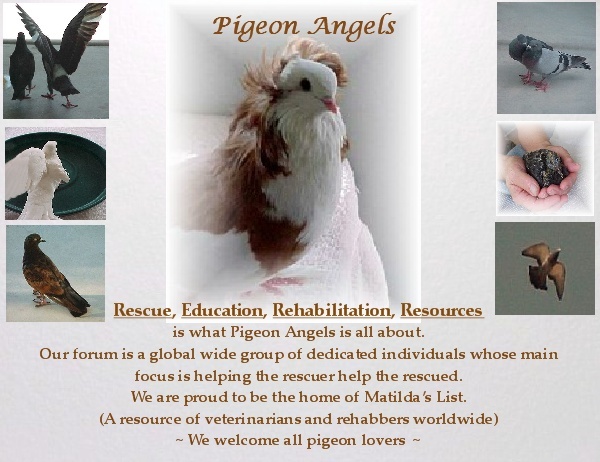Teresa
Administrative Member

Posts : 5381
Join date : 2009-07-23
Location : Portugal
 |  Subject: SUPPLEMENTING A DRY SEED DIET Subject: SUPPLEMENTING A DRY SEED DIET  Tue Jun 14, 2011 8:23 am Tue Jun 14, 2011 8:23 am | |
| At the time of year (for me, it's now) when the seeds used in pigeon mixes are almost a year old, our birds are getting less nutrients just when they may need them most. After complaining bitterly to my supplier about the old seeds, I found this article which is very helpful. It confirms the importance of offering raw vegetable salads, and states exactly what percentage of what a pigeon needs to be healthy.  THE DRY SEED DIET – ITS SUPPLEMENTATION TO ENHANCE HEALTH THE DRY SEED DIET – ITS SUPPLEMENTATION TO ENHANCE HEALTH
By Dr Colin Walker BSc, BVSc, MRCVS, MACVSc (Avian health)
Knowledge regarding the nutrition of pigeons is advancing every year. Thirty years ago, when I started racing, it was not unusual for many fanciers to just feed peas and wheat. It now seems incredible to us that fanciers would think that a diet made up of one, two or even three seeds would provide a complete diet. We now know that it is virtually impossible to supply all of the nutrients that pigeons require if fed only a dry seed diet, even if the variety of grains given is quite large.
Poor nutrition will suppress the birds’ ability to resist disease, compromise growth, prolong recovery from exertion or illness and decrease reproductive performance. However, it should be remembered that what the astute fancier is aiming for is not simply to avoid any obvious health problem but rather he wants the best diet possible so that his birds are at their best competitively.
Seeds form the basis of a balanced diet and supply protein, carbohydrates and fats. However, all seeds are deficient in some essential nutrients. For example, vitamin B12 is low or absent in almost all plant materials. It is really a matter of the informed fancier realizing that a dry seed diet cannot provide the optimal nutrition for his pigeons and then providing appropriate supplements to his advantage. There are a lot of backyard potions that have, unfortunately, crept into use that achieve very little. However, it is interesting that some of the older supplements do in fact do a lot of good. The choice of supplements is particularly challenging because it is important that they not only add to the diet but they are in a form that the pigeon will readily eat. A race bird is hardly going to race home or eat with relish a meal that is really good for it but is unpalatable. As mentioned above, although vitamin B12 is low or absent in almost all grain it is found in Baker’s and Brewer’s yeast (along with many other micronutrients). There are also a number of excellent inactivated sterile yeast supplements that contain none of the contaminants found in other yeasts (eg. The Australian Pigeon Company’s ID Yeast). Pigeons love the taste of yeast and so this has become a useful supplement.
In the grains used in most seed mixes, the following vitamins are usually limiting, in addition to vitamin B12: vitamin A, riboflavin, niacin, folic acid, vitamin K and vitamin E. The most limiting amino acids in most seeds are lysine, methionine and tryptophane. While the minerals likely to be limiting are calcium, manganese, sodium and in some cases copper, zinc, iodine and selenium.
And so how can the pigeon fancier add to his birds grain diet to make it more balanced and nutritious? I list below some practical sources of the nutrients that are low in seeds.
Vitamin A. Found in greens such as silverbeet and spinach and also carrot. Pigeons love a plate of mixed chopped greens and some will eat diced carrots. Dilute carrot juice can also be placed in the drinker. There is no risk of overdose here as the vitamin A is only found in its precursor form and the body will not absorb this and convert it to vitamin A if it is not needed. It should be noted that cod liver oil also contains good levels of vitamin A. Cod liver oil, however, also contains gizzerine, which is associated with stomach ulcers. This oil can also lead to vitamin E deficiency if allowed to go rancid, which it does quickly if exposed to sunlight, for example if it is mixed earlier in the day rather than being fed immediately.
Riboflavin. Found in yeast. I recommend an inactivated (sterile) dry yeast, eg ID Yeast, added to the seed after premoistening with a seed oil.
Niacin. Also found in yeast products. However, one seed that does contain good levels of niacin is sunflower. Do, however, be careful both sourcing and storing sunflower seed as it is very prone to fungal contamination.
Folic acid. Also found in yeast products but also wheat germ. Wheat germ oil is excellent to use as a moistening oil on grain. Added usually at the rate of 0.5 – 1 ml per kilogram of grain. This oil can be used to stick a yeast powder to the grain. The result is an especially nutritious meal. I know my own pigeons recognize the sound of this blend being mixed in their feeding bucket and start to act like kids waiting for lollies. Many of the better conditioning oils are based on wheat germ oil, eg Polyseed Oil.
Vitamin B12. As mentioned, also found in yeast products.
Vitamin K. There are two sorts of vitamin K produced naturally, vitamin K1, which is found in green leafy vegetables, and vitamin K2, which is produced by the normal bacteria in the bowel. Vitamin K2 levels can become low after antibiotics if probiotics are not used or if pigeons are not allowed to eat their own droppings.
Vitamin E. Found in vegetable oils.
Lysine, methionine and tryptophane. All found in yeast products and wheat germ oil. Lysine is also found in legumes, such as peas. In grain mixes containing 30% or more peas, deficiency is not a concern.
Calcium. Found in a range of soft grits, ie grits that are dissolved in the gizzard, such as cuttle fish, sea shells and calcite. A blended grit +/- pink mineral should always be available.
Sodium. Found in salt. Available in some grits and pink minerals. If fed only grain, pigeons will become voracious for salt and when a supplement is provided will eat it with gusto. This can lead to dehydration unless water is freely available. The recommendation is that salt form approximately 0.1% of the birds’ diet. The better brands of pink mineral on the market will contain this level, eg PVM Powder, which contains 11 g per 1 kg. Such supplements should be available continuously to avoid deficiency.
Manganese, copper, zinc and selenium. All found in yeast products.
Iodine. The level of iodine in seed is directly relatable to the levels of iodine in the soil in which the seed was grown. The level of iodine in many soils in Australia is quite low. Iodine is found in yeast or can be supplemented in the water. To do this, dilute 2 ml of Lugol’s iodine into 30 ml of water to make a concentrated solution. Then add 4 drops of this concentrated solution to each litre of drinking water.
It goes without saying that a good quality blend of grits should always be available to the birds to avoid not only these but other minerals.
Annual harvest
An important consideration in the feeding of grain is the annual harvest. Seeds grow in spring and are harvested once a year, leading to a cycle of progressively older seeds until the next harvest. At some time during the year, at least a portion of the seeds are one year old or older. The nutrients that are most affected by aging are the vitamins, which lose activity owing to oxidation and fats, which become rancid. This aging process can lead to a reduced nutrient concentration. In this way, the level of many other micronutrients becomes reduced with time. This reduction can be limited by reducing temperature and oxygen in the storage environment. This can be achieved by filling bins to the brim with grain before sealing the lids with tape and storing the whole drum in a cool place. Often, despite these measures, micronutrient levels become low. To guard against deficiency, a complete water-soluble multivitamin drink can be made available to the birds periodically (eg Multivite Plus) and pink mineral should be always available.
It is not only vital for race form to be achieved that the diet provide the birds with all the nutrients that they require but that it also supplies protein and fat at the correct levels. All seed diets tend to be high in fat but low in protein. This can result in obesity as the birds eat to meet both their energy and protein requirements. The correct level of protein in the diet of a racing pigeon during the racing season is approximately 12% and the correct level of fat is approximately 4%. There are many varied diets recommended and some of these provide significantly different levels of fat and protein. These appear fine in the short term but for long-term health the average level in the diet should approximate the above. The various diets have been discussed in my book, The Flying Vet’s Pigeon Health & Management. If the protein level in the diet is too low, normal enzyme and hormone activity cannot occur, healing and recovery are delayed, and muscle, bone and feather growth cannot occur normally. If the diet is too high in protein, this places an increased workload on the kidneys, which can be fatal. In one case at my clinic, stock pigeons started dying. Investigation revealed that they had died of kidney failure. The fancier had fed turkey pellets only (30% protein) for over 6 months.
The normal protein-based grain used is peas. Peas contain 20 – 25% protein and if they are the only protein grain used, and make up 35 – 40% of the diet, they will provide correct protein levels.
Excess fat in the diet leads to obesity, while, because fats are needed as an energy source, too low levels of fat lead to weight loss, poor growth and reduced disease resistance.
The balancing of various grains in the mix to provide correct levels of protein and fat not only for health but also to match the amount of work the pigeons are having so that their weight and fitness are correct to win is challenging and has also been discussed in my book. As a general rule, however, I recommend a base racing diet of 30 – 40% peas, with the rest being equal parts (ie 15%) maize, sorghum, wheat and safflower. To this is added one to two handfuls of mixed small seed (millet, canary, rape and linseed) per 12-litre bucket. Obviously there is no shortage of potential substitutions here, eg a proportion of the peas could be replaced with vetches, which are approximately 35% protein, but the level of peas would need to be reduced to prevent the protein level becoming too high. For breeding, a protein level of approximately 18% is recommended. This can be achieved simply by increasing the level of peas, beans (25% protein) or vetches.
Many successful fanciers will already recognize supplements as being beneficial and the following are recommended:
Complete multivitamin/trace element drink made specifically for pigeons at least one day per week in the drinking water (eg Multivite Plus)
Pink mineral and balanced grit (containing both hard and soft grits) always available (eg PVM powder and The Australian Pigeon Company’s Health Grit)
Wheat germ oil-based supplements together with yeast on seed for two or more feeds weekly (eg Polyseed Oil)
Chopped green vegetables with diced carrot weekly (or carrot juice diluted in water one day weekly)
Other supplements can have other advantages. Some of the teas commercially available not only contain micronutrients but also naturally occurring acids that help to protect the bowel from disease. It should be noted that there is no point in providing the correct blend of seeds if birds are then fed these cafeteria-style. It is a fallacy to think that pigeons know what they need and will only eat what they require. Many birds, if offered a blend ad lib, will overselect particular grains that they fancy, in particular oil-based grains such as safflower and peanuts. The selection of a smaller number of grains distorts the provided balanced diet. In addition a diet that contains excessive oil-based seeds although providing a reasonable protein intake also provides a lot of fat which distorts the amino acid balance. Such a diet is also very low in calcium and can interfere with the absorption of fat-soluble vitamins.
A poor diet means that birds are more prone to disease, poor feathering, poor reproductive performance and, of course, poor racing performance. The provision of a complete and balanced diet will optimize the performance of the competitive bird. | |
|
AZWhitefeather
Owner/Administrator

Posts : 10863
Join date : 2009-01-11
Location : Arizona Southwestern United States
 |  Subject: Re: SUPPLEMENTING A DRY SEED DIET Subject: Re: SUPPLEMENTING A DRY SEED DIET  Tue Jun 14, 2011 4:15 pm Tue Jun 14, 2011 4:15 pm | |
| Another great posting.  | |
|


